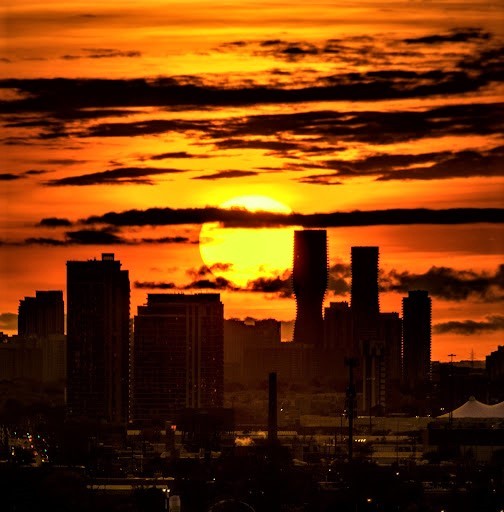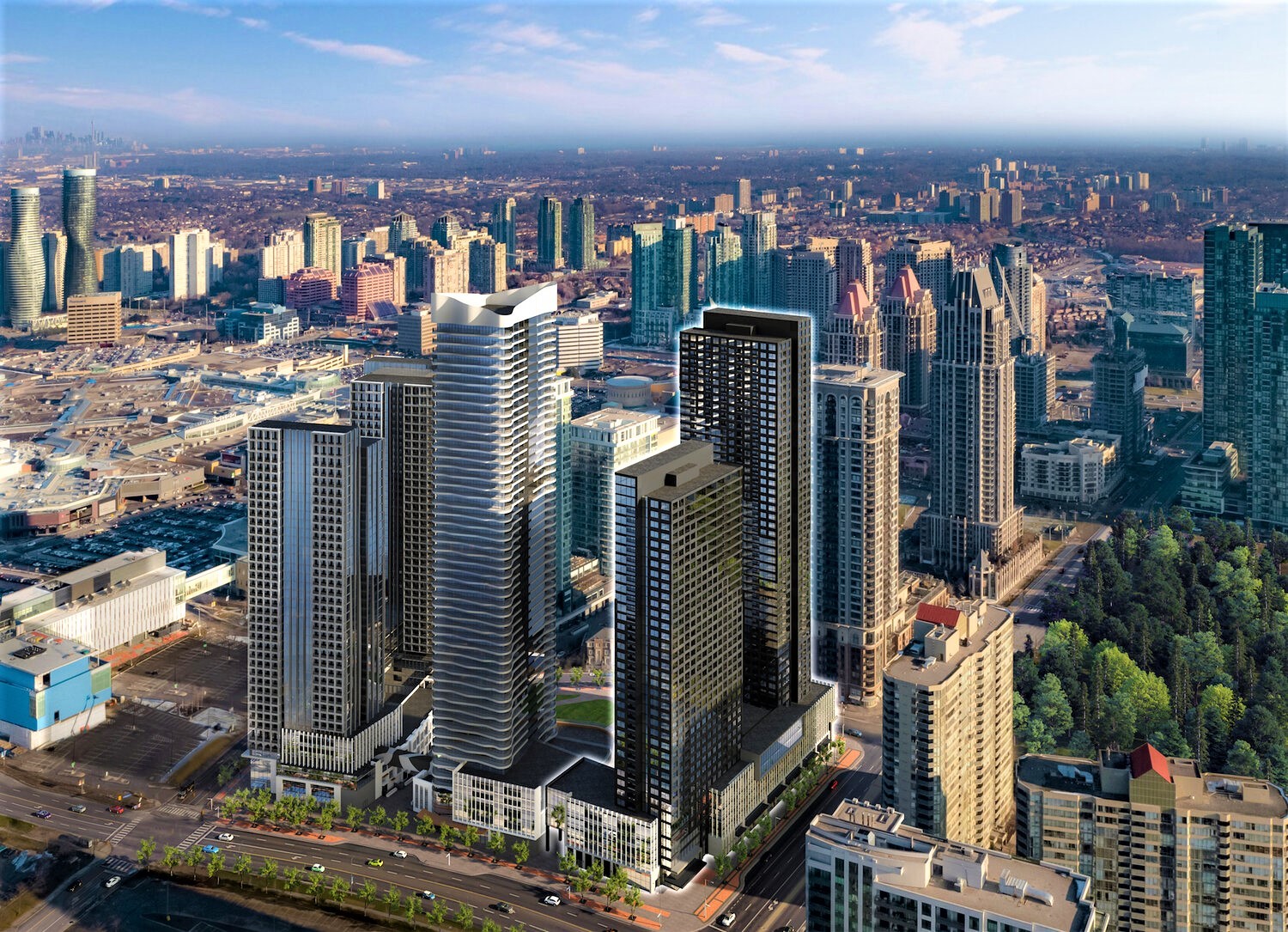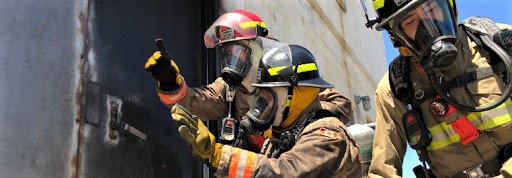
As Mississauga grows up (literally) towering buildings are forcing a rethink of how fires & other emergencies are dealt with
In a City lacking greenfield sites, the options for expanding are often up not out.
As Mississauga continues to grow in the next decade questions around where people will live, work and play become more pressing, leaving complex decisions to members of council, City staff and residents.
Mississauga will see an influx of new residents, with a projected population of 925,000 by 2051, based on the Region of Peel’s predicted growth and plans for the next 30 years. This expected growth forces City Council to plan smarter using the land left, as they and City planners try to undo the poor decisions made to accommodate the sprawl model of the past.
As of 2020, approximately 8,552 hectares of Mississauga were dedicated for residential use—71 percent of this was for single-detached homes. In contrast, barely five percent of the zoned residential land was used for apartment buildings, making up 1.5 percent of the entire City.
This is changing—fast.

The massive Oxford project planned for downtown Mississauga.
(Oxford properties)
With the pressing need to create complete communities that support transit and a more compact urban form, while hitting carbon emission-reduction targets, planning walkable communities and bringing more affordable housing, more high rise or multi-use towers/buildings are being approved and built.
While the tallest towers are part of the mix in a much more dense, urban model of planning (a huge financial advantage to City Hall compared to the unsustainable cost of servicing low-revenue sprawl) they create an added obstacle for firefighters responding to life or death emergencies.
“When you look at response times, the challenge that we have with high rise is not only do we have the horizontal response time additionally, now we have that time that it takes them to get up to whatever floor that is,” Mississauga Fire Chief Deryn Rizzi told The Pointer.
To improve the “horizontal response time” Mississauga has committed to building six new fire stations over the next decade or so, a solution long overdue. Former fire chief Tim Beckett estimated that if the department wanted to reach the National Fire Protection Association (NFPA) standard of arriving within four minutes 90 percent of the time, the city would need a total of 44 fire stations; currently there are only 21.
Even without the failure of local elected officials to properly budget and plan for new stations as they allowed growth to explode, Mississauga Fire & Emergency Services (MFES) faces other challenges with the increase in population, with traffic and construction contributing to response times that have been far longer than the NFPA target.
On average in 2020, MFES arrived on scene in 298 seconds (almost five minutes) 75 percent of the time. The target time is set for when the fire department is dispatched to the scene and arrives at the call, it does not include the additional time needed to climb inside high rise buildings.
Mississauga Fire’s goal is to have the first vehicle reach the site within four minutes about 75 percent of the time.
A lack of investment from City Hall has left the service without the needed number of stations across the booming municipality. Without more stations, firefighters need to travel farther distances, increasing their response time, while also decreasing (in some cases) chances of survival.
Studies have shown that for every 60 seconds without intervention after a cardiac arrest, the chances of survival are reduced by 7 to 10 percent. The fire department often has to accompany paramedics in certain emergencies when fire or other potential risks pose a threat to first responders.
So, before paramedics can get to a heart attack victim, firefighters sometimes have to clear the way.
Paul Snobelen, Peel Region’s specialist in community resuscitation programs, told The Pointer recently that vertical growth poses major problems.
In medical emergencies like a cardiac arrest, when every minute is critical, the time paramedics spend waiting for an elevator to arrive on the ground floor can mean the difference between life and death. The higher you live, the lower your chance of survival, especially if your floor is in the double digits.
For condo dwellers, a study completed by York Region Paramedic Ian Drennan in 2016 found the “death zone” is pretty much everything above the 16th floor.
In the event of a heart attack, “science shows you’re dead,” Snobelen said.
Drennan’s study of over 7,000 cardiac arrests in Toronto and Peel found that for those who collapsed above the 16th floor, the survival rate was less than 1 percent. There were no survivors above the 25th floor.
“Vertical is now the new challenge,” Snobelen said. “We know that’s going to become a bigger challenge in this region.”
Approximately 85 percent of cardiac arrests occur inside the home. When more of those homes are constructed high off the ground in multi-storey condos, accessed only by climbing multiple floors or through an elevator, it makes timely, effective response by paramedics and firefighters very challenging.
Vertical response, the deployment of firefighters to the upper levels of buildings, will be an even more significant factor in the near future for MFES. Currently, the City’s tallest building is the southernmost Absolute building (Marilyn Monroe tower) in downtown at 56 storeys.
But taller buildings are coming.

Above, the M City development now under construction, with a total of eight condo towers.
(Rogers Real Estate Development Ltd. & Urban Capital)
In the summer of 2020, Mississauga broke ground on the largest tower in the M City development, located at Burnhamthorpe Road and Confederation Parkway just south of City Hall. When constructed, M3, one of the three condo towers currently being built, will be 81 storeys, housing 900 units.
The M City development will eventually include eight condo towers, one of the others will stand 77 storeys; the Oxford Properties development surrounding Square One will include a staggering 37 towers, the initial construction includes two towers of 36 and 48 storeys; there’s the Oro at Edge Towers, 50 storeys; Artform Condos, 17 storeys; Gordon Woods, 29 and 36 storey towers; and Westport Condos, 22 storeys, to name just a few of the dozens and dozens of planned developments.
When responding to a fire, Rob Grimwood, deputy chief training and technology, explained firefighting is about covering all the bases and seeing which tactic will work for each scenario.
“If the fire goes according to plan, which means that it's compartmentalized in the unit of origin, then vertical response time would be our biggest challenge,” he said.
But there are so many other factors in high rise buildings that fire crews have to take into consideration. Fires are unpredictable until crews can understand the problem at hand. If the unit containing the fire has a window or patio door open, the situation changes. If the fire escapes the unit and fills the hall with smoke because a door was propped open, fire crews have to change tactics.
“In a high rise fire where all the building systems operate the way they should, our biggest challenge is assembling enough personnel and getting them to the fire floor,” Grimwood said. “If any of those components fail, our biggest challenge then becomes overcoming them.”
In 2011, MFES conducted a study for the average vertical response time of crews climbing the stairs and using the elevator. To reach the 5th floor of a building, it takes firefighters approximately four and a half minutes, using the elevator it takes three minutes, 23 seconds. The higher the floor the more fatigued a person gets carrying equipment, ultimately making the response time slower.
However, the elevator travel time stays consistent, taking three minutes, 23 seconds to reach the 10th floor and three minutes, 26 seconds to reach the 15th floor. Using the elevator saves MFES time when responding and allows them to easily carry equipment throughout the building.
Since 2011, technology has changed making the average elevator time slightly longer and not a full depiction of MFES vertical response time.
According to research by the National Institute of Standards and Technology for the United States, fire crews using elevators in a high rise building have a quicker response time to the scene.
“Most of the reductions due to elevator usage were in the 2 min to 4 min range, with a few obvious exceptions in that using fire service access elevators more dramatically reduced times associated with upward and downward transport of people or equipment,” the report concluded.
In each scenario different factors were added, such as the detection of smoke alarms, how many firefighters there are and the height of the building. Overwhelmingly through each situation, fire crews were able to respond to the task at hand much faster when using the elevator compared to the stairs.
Mississauga is not the only municipality having to deal with the reality of vertical growth. In 2015, Toronto Fire Services (TFS) updated City Council on its fire master plan in regard to vertical response times.
The report from TFS detailed how response time standards from NFPA did not include vertical travel time.
“The current and historic standards contain no performance targets for vertical response; however, response standards for low-rise and high-rise residential buildings are being developed and reviewed by the NFPA,” it stated in 2015.
TFS has been recording vertical response time by crews since 2013, and had, “began an initiative, in advance of the NFPA standards being updated, to track and improve vertical response.”
In 2015, TFS’ vertical response time ranged between 5 minutes, 12 seconds to 5 minutes, 34 seconds.
MFES’s 2019 Fire Master Plan also acknowledges vertical response times as an issue, saying “longer response times can occur for emergency response to high-rise occupancies due to the 'vertical response' factor.”
The plan doesn’t include further statistics or next steps for the department to tackle the problem.
“Once the standards are adopted, TFS can use them as a benchmark to measure vertical response time performance for getting an Effective Firefighting Force on scene,” reads the TFS report.
Ken Holland, senior emergency services specialist for NFPA told The Pointer there is no standard for vertical response time in the most recent set of codes/standards.
“The committee just stayed silent on it and left it up to the authority of the jurisdiction to come up with that,” Holland said. “It doesn't mean that the committee couldn't address it, maybe in the future.”
In order to address standards, cities or members of the public can submit a form to the committee of NFPA. Every five years the standards are updated, with the most recent edition published in 2020.
When TFS raised this issue in 2015, the service nor council ended up submitting a review to the committee, Holland confirmed with The Pointer.
Holland, a former firefighter and paramedic, explained how the conversation on high rise responses to emergencies will be shaping standards in the future.
“The clock starts from the point when you get on scene, but what about that time from when you get out of the vehicle? And then you've got to go up 30 storeys,” he said. “The conversations are occurring, [but] the best way to get in front of the committee is to submit a public input.”
The lag from TFS on submitting a review opens the door for MFES to try and be on the cutting edge of response times, assisting the NFPA in defining the modern way to fight fires in high rise buildings.
Grimwood told The Pointer a standard would be “helpful” and that it’s a “part of the puzzle.”
“I can certainly see the fire service interest in it, and it wouldn't surprise me at all that that's included in the next revision,” he said.
When an alarm goes off in any building, elevators automatically recall to the ground floor (or a separate floor if the ground floor is the scene), giving firefighters the opportunity to use technology to their advantage.

Firefighters train for numerous scenarios, but high rises pose unique challenges.
(City of Mississauga)
Inside the elevator, crews have a key to control the technology choosing which floors to stop at.
If a fire is on the 25th storey, firefighters would take the elevator up two floors below to ensure safety and carry equipment to the scene. This would only be the case if the smoke alarms on floors 24, 23, 22 have not gone off, if that occurs crews mobilize on floor 20 and work their way to the fire.
When the location of the fire is established, crews attach hoses to tap into the building's water source ultimately being able to extinguish the fire.
“These elevators are very well protected in modern high rise buildings,” Grimwood told The Pointer. “It's an intricate part of the system.”
However, the higher the building the longer the elevator ride. So even if crews respond in a timely manner to the scene and access the elevator, responding could take longer just because of the height. This is crucial for MFES who already have a slower response time.
Knowing the challenges presented to them, MFES respond to high rise fires differently than emergencies in single detached homes. According to Grimwood, a house fire would see five trucks and one district chief to the scene, from there the situation would get upgraded or downgraded. When MFES respond to calls in high rises, immediately sent are seven trucks, two district chiefs and a platoon chief.
“We know the vertical response time has an impact and we know it's a more strenuous call physically, so right off the first 911 call, we actually resource those calls at a higher level,” Grimwood said.
There are a few ways the department can deal with the added pressure of calls. One of the most common and easily effective ways to respond to less fires is by increasing education and understanding of smoke alarms.
The chances of survival increase two fold when a smoke alarm is present, making it one of the best ways to avoid a disastrous fire. It is the law in Ontario to have one on every level of residential buildings, but still MFES find some households are not complying.
Of the calls MFES responded to in the past five years an average of 43 percent of incidents had no working smoke alarm and a further 60 percent of those calls either had no working smoke alarms or the presence could not be determined.
In high rise buildings home to multiple units, the responsibility of working fire systems falls on the property manager to conduct routine inspections and invite third parties inside to test and verify devices.
To counteract this, MFES is increasing their educational programs and fire safety initiatives in 2022.
Nigel Robinson, division chief fire prevention and life safety told The Pointer in an interview, MFES is partnering with the Mississauga Food Bank to hand out 500 dual smoke and carbon monoxide alarms to users in early 2022.
This year, Mississauga fire’s budget is adding $9.4 million in continuing education and inspection, most of which comes in the form of staff, allowing households to be reached across the City. One program allows fire suppression crews to become familiar with buildings, looking for fire safety concerns. The increase in staff allows more properties to be inspected and decreases the chance for an incident to occur.
Chief Rizzi told The Pointer in an email, “In the event we identify a property with a trend of incidents, false alarms, or similar, our Public Educators will deliver 'in person' targeted high rise fire safety information to the building and occupants, directly related to the issue of concern.”
Compared to other cities across Canada, Mississauga is in a relatively good position when it comes to fire suppression tactics. Most of the City’s building stock is newer, especially the towers popping up, this means all will comply with a strict building code.
“The way those buildings are put together now, with fire control, and fire suppression systems, sprinklers, and smoke control measures,” Stephane Malo, deputy chief operations, told The Pointer. “They're essentially non combustible buildings, it makes our lives much easier.”
Before the construction of any building in the City can be approved, the design must go through MFES. This allows the service to make sure all new and up to code fire suppression and safety standards are being used. If a fire does break out in a high rise building, there are less opportunities for the fire to spread and grow out of control because of the increased safety measures implemented.
Grimwood lives on the 11th floor of a 35 storey high rise.
“I've been in the fire service 26 years and I wouldn't live in a high rise building if I had any concerns [of safety] whatsoever,” he said.
Mississauga’s rapid growth will need to go somewhere, and while council and residents can imagine the future, it’s up to the city's fire department to define how modern day firefighting will look in the decades to come.
Email: [email protected]
Twitter: @taasha__15
COVID-19 is impacting all Canadians. At a time when vital public information is needed by everyone, The Pointer has taken down our paywall on all stories relating to the pandemic and those of public interest to ensure every resident of Brampton and Mississauga has access to the facts. For those who are able, we encourage you to consider a subscription. This will help us report on important public interest issues the community needs to know about now more than ever. You can register for a 30-day free trial HERE. Thereafter, The Pointer will charge $10 a month and you can cancel any time right on the website. Thank you
Submit a correction about this story


